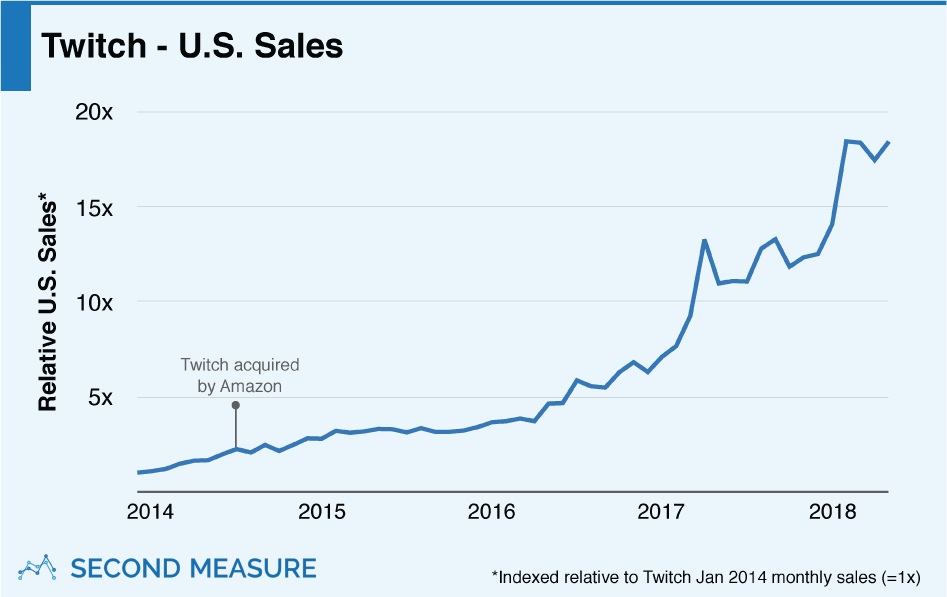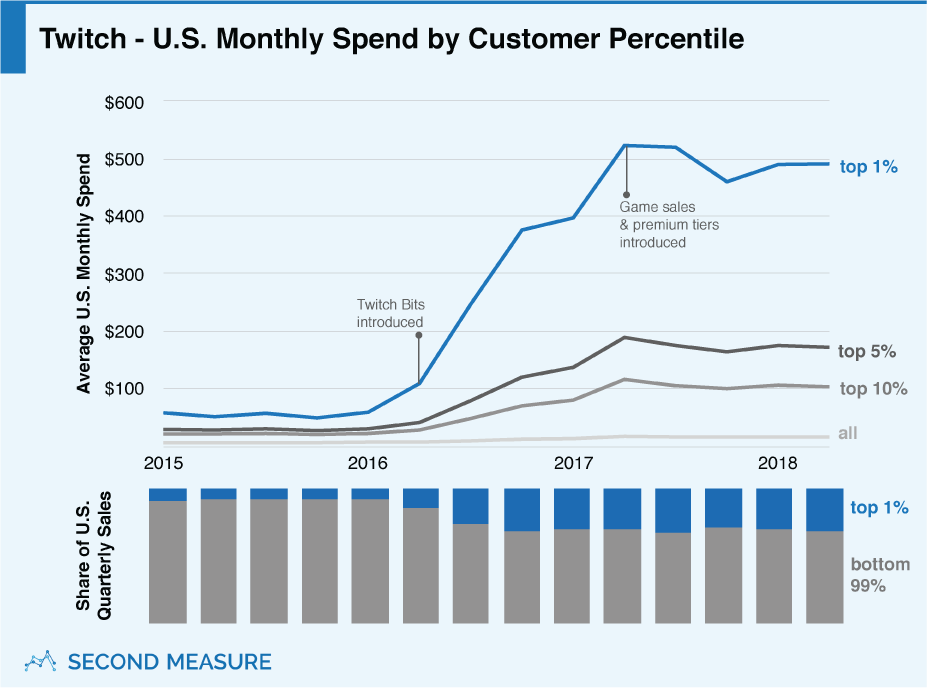NOTE: Bloomberg Second Measure launched a new and exclusive transaction dataset in July 2022. Our data continues to be broadly representative of U.S. consumers. As a result of this panel change, however, we recommend using only the latest posts in assessing metrics, and do not support referring to historical blog posts to infer period-over-period comparisons.
Tonight, the Overwatch League Grand Finals—a video game championship—will air on primetime ESPN. The TV crossover is expected to be the first of many because, when it comes to watching other people play video games, esports fans are known to go big. How big? Another video game tournament, featuring the multiplayer battle game Dota 2, has raised over $22 million (and counting) in crowd-funded prize money since May. And these tournaments are just a fraction of the industry. Millions of spectators go online every day to watch esports via Twitch, Amazon’s streaming platform for gamers, which more than doubled its U.S. sales last year.
Twitch currently has 2 million active broadcasters streaming Overwatch, Dota 2, and thousands of other games. Most of them are amatuer gamers, but viewers shell out big time for Twitch’s broadcast partners—elite players who receive a share of the profits generated by their Twitch channels.
Though Twitch’s channels are free to watch, spending data shows there’s no shortage of esports fans willing to pay for an upgraded viewing experience. In 2017, the platform saw its annual U.S. sales increase 120 percent over the year prior. Previously, spending rose dramatically after Amazon paid nearly a billion dollars for the platform in 2014, with annual sales growing by 76 percent the following year.

Twitch’s top spenders are esports’ biggest cheerleaders
Much of Twitch’s spending comes from megafans, and their viewing habits can really add up—the top 1 percent of customers account for over 30 percent of all spending on the site. Last quarter, these esports whales spent an average of $491 per month on Twitch.

Twitch’s top spenders weren’t always such high-rollers. At the start of 2016, Twitch’s best customers spent just $59 per month, on average, and accounted for just 9 percent of total sales. Then, the release of Twitch Bits in June 2016 corresponded with a major uptick in spending among the top 1 percent, which grew to $376 per month by the end of the year.
Clearly, Bits have been a game changer for Twitch’s biggest fans, so what exactly are they? A platform currency, Bits allow viewers to “cheer” for their favorite players during thrilling gameplay, and those cheers translate to real money in the bank for the broadcaster. Twitch Bits can be purchased in a variety of denominations at multiple price points, effectively monetizing the emotional investment viewers have in the game, which can run pretty deep.
Root, root, root from your home screen
Curious what else video game spectators spend so much money on? As esports have evolved, that breakdown has changed, though the intent remains much the same: to register support and enthusiasm for their favorite gamers.
Twitch’s U.S. sales come primarily from viewers spending $4.99 per month for a basic subscription to a player’s Twitch channel, supporting the gamer financially while unlocking chatroom status symbols—like custom emotes—among other perks. As of last month, 69 percent of transactions on Twitch were $4.99.
That proportion was previously even higher. Two years ago, $4.99 channel subscriptions dominated spending, accounting for over 90 percent of all purchases. The other transactions were primarily for the Twitch Turbo plan, an $8.99 per month upgrade to ad-free viewing. (Twitch Turbo began phasing out in 2016, replaced by a complimentary perk of Amazon Prime membership: Twitch Prime.)

Over the past couple years, Twitch has broadened its offerings for paid subscribers with added products and enticing deals. In April 2017, Twitch started selling video games directly through its platform in addition to releasing premium subscription tiers costing $9.99 or $24.99 per month. Right off the bat, the new offerings drew more spending and, from March to May, transactions doubled for price points other than the basic $4.99 subscription. Over those two months, Twitch Bits sales also grew rapidly, as purchases tripled at the most popular price point ($7 for 500 Bits).
More recently, Twitch has started putting small-ticket items on sale, driving an increase in transactions under $4.99. In September and December 2017, Twitch ran promotions that offered first-month discounts to subscribers when joining a new channel. The deals account for corresponding dips among $4.99 purchases, as total transactions continue to climb.
Then, in April 2018, Twitch announced it would start allowing Bits to be spent on more than just cheering. Twitch extensions allow a channel host to overlay new features, like polls and mini-games, which viewers can now interact with by spending Bits. Also in April, 500 Twitch Bits went on sale for just 99 cents (normally a $7 value) and, that month, 14 percent of all transactions on Twitch were 99 cents, while 99-cent transactions were essentially nonexistent throughout the rest of the past year.
Twitch banks on farm team gamers to drive future sales
As esports grow, social media powerhouses are making moves into the industry, and Twitch seems aware of the need to keep top talent concentrated on its site. Twitch’s new Creator Camp will help foster broadcasting prospects who, in turn, will attract more viewers to the platform. It’s easy to see why gamers aspire to a Twitch partnership: one esports superstar, nicknamed Ninja, confirmed his ballpark earnings from Twitch subscriptions alone are more than $500,000 per month.
For more on Twitch, touch base with us about starting a demo.
Oh, and we’re hiring.
